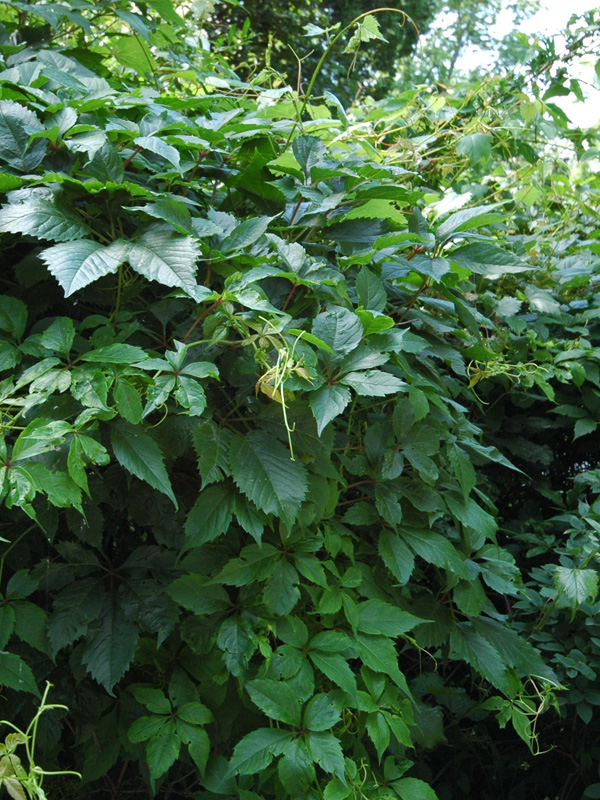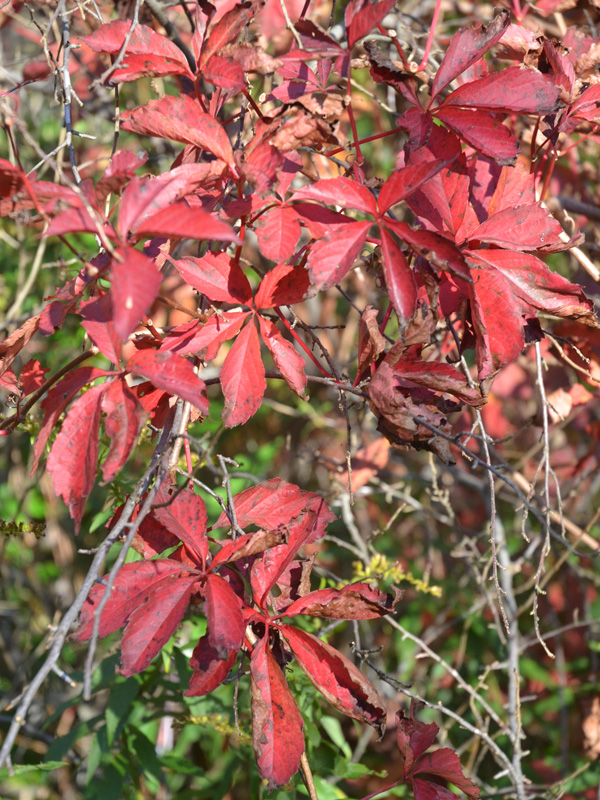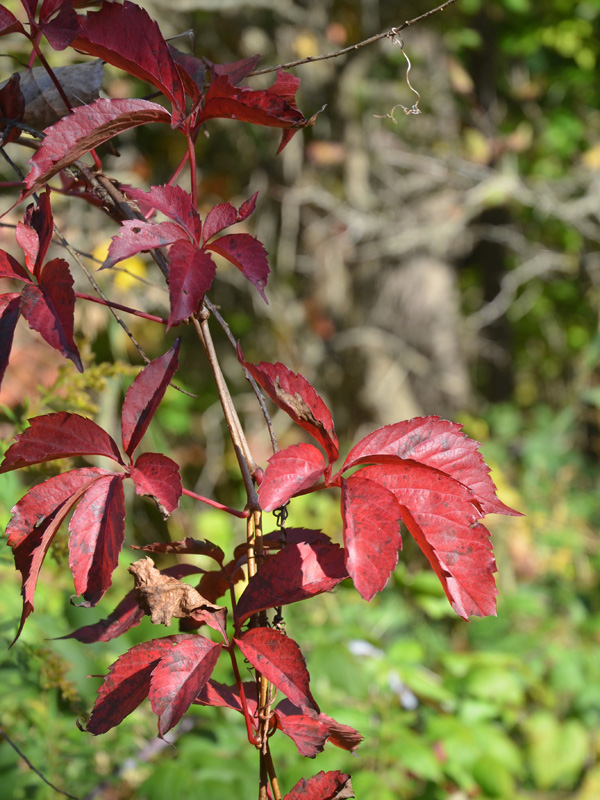
Woody > Parthenocissus > Parthenocissus quinquefolia > Parthenocissus quinquefolia
Parthenocissus quinquefolia
Virginia Creeper
Origin: Eastern North America.

"
A hardy deciduous vine grown for its intense red autumn foliage and strongly vigorous nature, Virginia creeper is often mistaken in the wild for poison ivy (Toxicodendron radicans) by the layperson, however it can be distinguished by its compound leaf composed of five leaflets compared to poison ivy’s three leaflets. Fast-growing and tolerant of a wide range of conditions, it often finds ornamental use trained up walls, fences and arbours. It is grown on trellises for screening, is used on shaded hills for erosion control, and can be used as vigorous self-rooting groundcover. The stems send out sucker-tipped tendrils which attach themselves to surfaces with a very strong natural adhesive, letting the plant support its own weight while climbing to great heights. It has a narrower vertical habit compared to its broader spreading cousin, Boston ivy (P. tricuspidata), and wide walls require multiple plantings to fully cover. One must be certain where they intend to use this vine as the residue from the sucker-tips is near impossible to remove. It requires strong pruning to keep under control, and once established the vine is difficult to remove completely. The bitter berries, popular among wildlife, are toxic to humans and the sap can be a skin irritant to sensitive individuals. The seeds spread by birds can lead to Virginia creeper seedlings growing as weeds in the surrounding area. However, any gardener willing to put up with the physical maintenance required will be rewarded with lush climbing green cover and, come autumn, with beautiful red foliage that shows up all but the most exotic flower blooms.
Michael Pascoe, NDP., ODH., CLT., MSc. (Plant Conservation)
"
| Family |
| Vitaceae |
| Genus |
| Parthenocissus |
| Species |
| quinquefolia |
| Category |
| Woody |
| Type |
| Vine |
| Pronunciation |
| USDA Hardiness Zone |
| 4 - 9 |
| Canadian Hardiness Zone |
| 3 - 9 |
| RHS Hardiness Zone |
| H7 |
| Temperature (°C) |
| -34 |
| Temperature (°F) |
| -30 |
| Height |
| 10-20 m |
| Spread |
| 10-20 m |
| General Description |
| Virginia creeper is a deciduous climbing vine with deep green foliage which grows to cover walls and structures very quickly. Leaves change to a showy red in early autumn. |
| Landscape |
| Virginia creeper is a climbing vine which upon establishing itself is easily trained up walls and other structures to produce impressive vertical green spaces. It can climb 20 m or higher, limited only by the structure it grows on. Dramatic autumn foliage as the leaves turn an intense red, purple-red in shade to scarlet grown in full sun. Dark blue berries remain after leaves have dropped for further aesthetic value until early winter, and attract many species of songbird. It is also used as permanent groundcover for controlling soil erosion in steep areas where grasses are insufficient and trees and shrubs are difficult to establish. |
| Cultivation |
| Although it favours acidic soil this vine will readily grow in dry, alkali soils, and is also quite tolerant of urban conditions such as air pollution and salt. It grows in full sun to full shade. Vigorous growth of 2-3 m per growing season must be pruned strongly to prevent overgrowing walls and choking eaves troughs, climbing unwanted onto nearby trees, or creeping along the ground into nearby gardens. Prevention is key, thinking ahead to note how far the vine will grow and what is in the way. Removing a large amount of growth (1-2 m) once or twice per year is preferable to simply trimming around the edges as Virginia creeper will quickly make up for lost ground. |
| Shape |
| Climbing spreading vine. |
| Growth |
| Fast |
| ID Characteristic |
| A climbing vine, distinguishable by its palmately compound leaves composed of five obovate leaflets, and thick sucker-tipped tendrils growing opposite leaves which permanently attach to surfaces. Dark blue berries 4-7 mm in diameter are visible upon loss of foliage. |
| Pests |
| None major. Japanese beetle, and in the southern United States the larvae of the Virginia creeper sphinx moth, are defoliators. Powdery mildew. |
| Habitat |
| This vine grows naturally in moist acidic soils throughout the eastern United States and is part of the ecology of climax forests in that area. It can be found in open and shaded woodlands, on riverbanks and along streams. |
| Bark/Stem Description |
| Bark on large stems is deeply furrowed and light brown. Younger stems are reddish brown and finely pubescent with clear lenticels. |
| Flower/Leaf Bud Description |
| Virginia creeper has sessile, collateral buds which have a broadly conical form. The unobtrusive buds are brown in colour, clearly scaled and only 1-2 mm in length. |
| Leaf Description |
| The leaves of Virginia creeper are palmately compound consisting of five pinnate leaflets varying in size from 3-15 cm long and 2-8 cm wide, on petioles from 2.5-10 cm long. Leaves are alternately arranged, serrate to doubly serrate at the margin, with a shape from lanceolate to obovate. |
| Flower Description |
| Virginia creeper has determinate inflorescences consisting of green to yellow-white cymes. These cymes occur in large numbers, taking a form similar to panicles. Each flower is perfect and approximately 6 mm in diameter. |
| Fruit Description |
| The flower produces a fleshy berry containing 1-3 seeds. The berries are blue-black to dark purple with a size of 4-7 mm, and a round form flattening slightly at the apex. They contain oxalic acid, making them toxic to humans and many other mammals although birds are unaffected. |
| Colour Description |
| Foliage is dark green in summer, changing very early in autumn to a spectrum of red from dark purple-red to bright scarlet. Stems are light brown, though young growth has a reddish tinge. The berries are dark purple to blue-black, with a clear bloom when ripe. |
| Texture Description |
| Medium textured from spring to autumn, coarse in winter when defoliated. |
| Notable Specimens |
| City Hall of Quedlinburg/Saxony-Anhalt, Harz, Germany. Fanshawe College, London, Ontario, Canada. Joany’s Woods, West Williams, Middlesex County, Ontario, Canada. |
| Propagation |
| Virginia creeper can be propagated by seed, clonally or via layering. Seeds must either be sown in autumn at 1 cm depth, or stratified for 6-8 weeks at 5°C, allowed to germinate in moist soil in a warm location, and grown indoors for one full season before being transplanted outside in late spring. To grow clones, cuttings taken in summer should be rooted in moist soil and allowed to grow indoors over winter. After the last frost in late spring, they can be transplanted to their final position. Virginia creeper grown as groundcover often self-layers but layering can be forced by sharply bending a softwood stem in spring and staking the bend into the ground, covering with a thin layer of moist soil and leaving the end exposed. |


